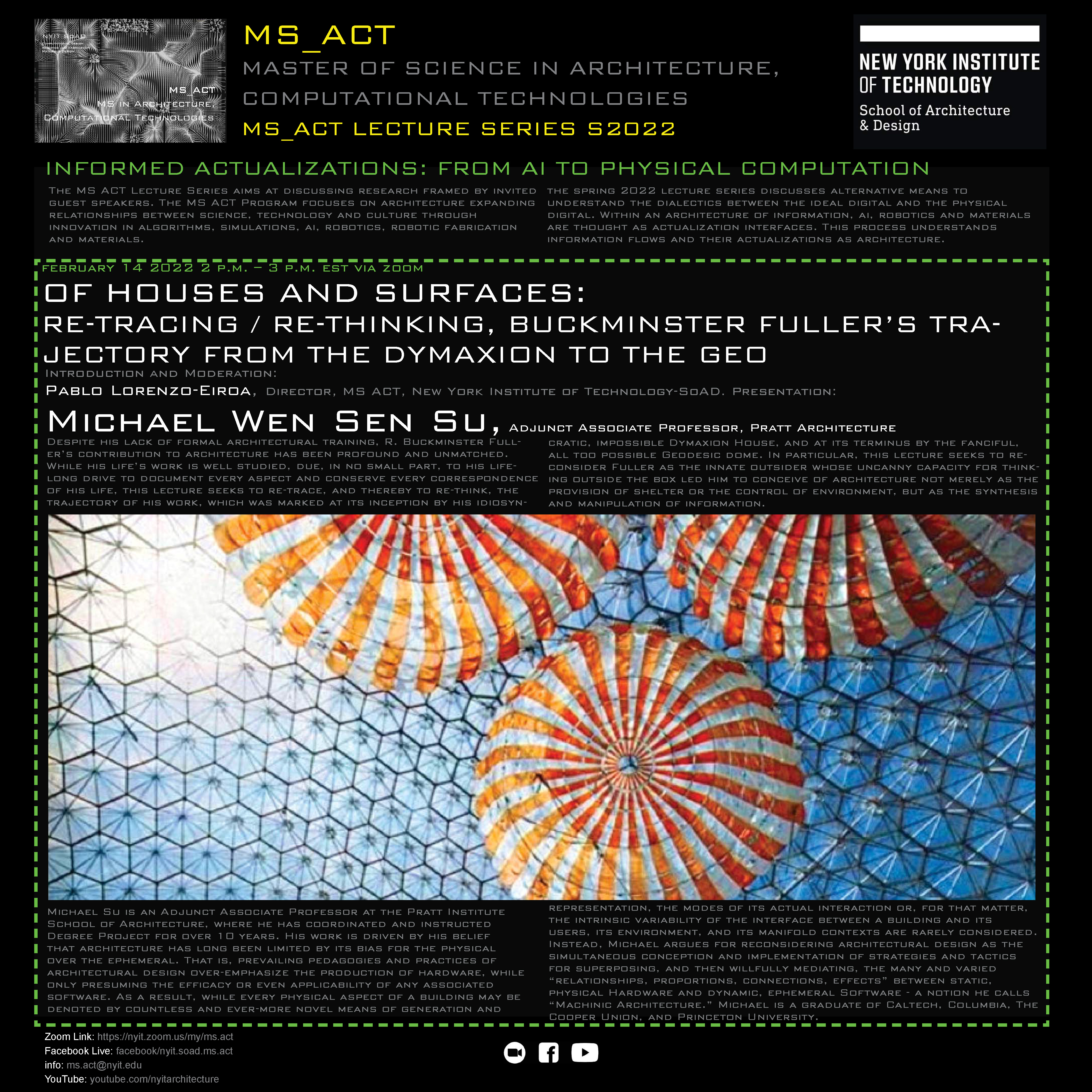Architecture Computational Technologies
Explore design research at the frontiers of architecture through experimentation in computational design, robotic systems applied to fabrication and interactivity, and materiality. For more information please contact ms.act@nyit.edu
Buckminster Fuller's trajectory - Dymaxion to the Geo Lecture by Michael Wen Sen Su, Pratt Institute
MS_ACT
Master of science in architecture,
computational technologies
MS_ACT LECTURE SERIES S2022
Informed Actualizations: From AI to physical computation
The MS ACT Lecture Series aims at discussing research
framed by invited guest speakers. The MS ACT Program focuses on architecture
expanding relationships between science, technology and culture through
innovation in algorithms, simulations, ai, robotics, robotic fabrication and
materials. The spring 2022 lecture series discusses alternative means to
understand the dialectics between the ideal digital and the physical digital.
Within an architecture of information, ai, robotics and materials are thought
as actualization interfaces. This process understands information flows and
their actualizations as architecture.
February 14 2022 2 p.m. – 3 p.m. est via zoom
Of Houses and Surfaces: Re-tracing, and re-thinking, R.
Buckminster Fuller’s trajectory from the Dymaxion to the Geo
Introduction and Moderation:
Pablo Lorenzo-Eiroa, Director, MS ACT, New York Institute
of Technology-SoAD
Presentation:
Michael Wen Sen Su, Adjunct Associate Professor, Pratt
Institute School of Architecture
Despite his lack of formal architectural training, R.
Buckminster Fuller’s contribution to architecture has been profound and
unmatched. While his life’s work is well studied, due, in no small part, to his
lifelong drive to document every aspect and conserve every correspondence of
his life, this lecture seeks to re-trace, and thereby to re-think, the
trajectory of his work, which was marked at its inception by his idiosyncratic,
impossible Dymaxion House, and at its terminus by the fanciful, all too
possible Geodesic dome. In particular, this lecture seeks to reconsider Fuller
as the innate outsider whose uncanny capacity for thinking outside the box led
him to conceive of architecture not merely as the provision of shelter or the
control of environment, but as the synthesis and manipulation of information.
Michael Su is an Adjunct Associate Professor at the Pratt
Institute School of Architecture, where he has coordinated and instructed
Degree Project for over 10 years. His work is driven by his belief that
architecture has long been limited by its bias for the physical over the
ephemeral. That is, prevailing pedagogies and practices of architectural design
over-emphasize the production of hardware, while only presuming the efficacy or
even applicability of any associated software. As a result, while every
physical aspect of a building may be denoted by countless and ever-more novel
means of generation and representation, the modes of its actual interaction or,
for that matter, the intrinsic variability of the interface between a building
and its users, its environment, and its manifold contexts are rarely
considered. Instead, Michael argues for reconsidering architectural design as
the simultaneous conception and implementation of strategies and tactics for
superposing, and then willfully mediating, the many and varied “relationships,
proportions, connections, effects” between static, physical Hardware and
dynamic, ephemeral Software - a notion he calls “Machinic
Architecture.” Michael is a graduate of Caltech, Columbia, The Cooper
Union, and Princeton University.
Video of the presentation and discussion:
More Posts
All PostsMay 31, 2022
MS_ACT INNOVATION KEYNOTE LECTURE Kaicong Wu
May 26, 2022
MS ACT Lecture Shai Yeshayahu
May 16, 2022
